Contributing Writer
Fleets Move Toward Predictive Maintenance to Prevent Breakdowns, Reduce Expenses
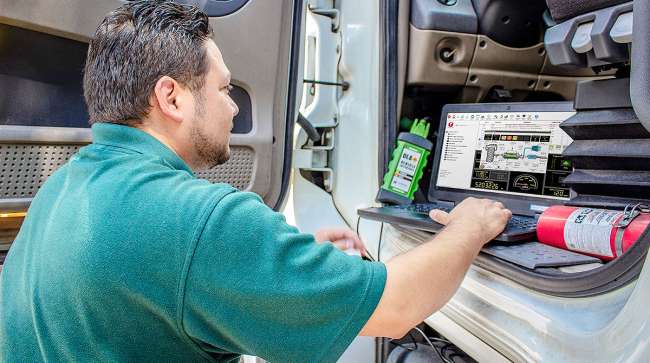
[Stay on top of transportation news: Get TTNews in your inbox.]
Predictive maintenance holds the potential to help fleets prevent vehicle breakdowns while reducing upkeep costs by predicting when parts will fail based on performance data and other information.
But this data-driven approach to maintenance is still in its early stages, and questions about warranties and other issues must be answered before a widespread shift in industry practices can occur.
However, the growing amount of information captured by onboard sensors and telematics systems already is enabling fleets to take an increasingly proactive stance toward equipment repairs.
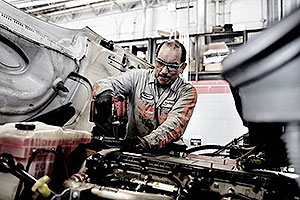
A Ryder technician works under the hood. (Ryder)
“From winterization practices to aftertreatment systems to maintenance intervals, we have used the data to influence our actions and drive lower downtime for our customers,” said Cindy Crawford, group director of maintenance, technical and engineering at truck-leasing company Ryder.
Frito-Lay North America, a unit of PepsiCo, said its fleet began using predictive maintenance practices in 2017. A predictive electrical system maintenance program identifies cranking voltage issues and automatically generates work orders.
These practices have resulted in a measurable decrease in on-road breakdowns and spending and have reduced technician diagnostic time, the company said.
Predictive maintenance is in its “nascent stages,” said Dave Covington, chief technology officer at Noregon, a provider of commercial vehicle diagnostics and data analytics.
Trucks are “Frankensteins” with many components supplied by many companies, and they are ever changing. In fact, trucks are generating so much data that the costs of storing and transferring it can be prohibitive.
Rick Tapp, maintenance manager for PacLease, said predictive maintenance will become more common when fleets better understand not only fault codes, but what they could have done to prevent them in the first place.
“That’s really what’s going to send this thing into orbit,” he said.
Predictive maintenance shows great promise, but Sanjiv Khurana, general manager of digital vehicle solutions at Daimler Trucks North America, doesn’t want to overpromise.
He said the truck manufacturer has been on a “journey” toward predictive maintenance. At this point, it can provide carriers with meaningful fault codes and action plans, but he’s skeptical that anyone in the industry can do more.
“I’ve heard a lot from a lot of different companies about being able to predict failures at the part level, and I’ll be honest: I haven’t seen that yet, and I don’t see anyone in the industry really being able to say I can predict an alternator will fail at this point X in time or EGR coolant will fail at this point Y in time,” he said.
Steve Chaffee, director of fleet IoT at Hitachi America, said predictive maintenance allows fleet maintenance to be more fluid and better timed. Yard management is run less like a hospital triage operation. Fleets can better deploy technicians. Less time, or no time, is spent waiting for parts to arrive at dealerships. Fleet managers know if the truck can complete a load even if a fault code is flashing. The data also enables “prescriptive maintenance, meaning we also give them some idea on how to fix this truck,” he said.
The proliferation of vehicle data can help fleets, and the entire industry, learn from trends and increase performance.
“You can imagine that you have a lot of trucks on the road, and most of them spitting out data,” Chaffee said. “It’s not just that truck’s data that we’re looking at. We’re looking at that truck as it relates to other trucks … and how those are performing under certain circumstances, and it just becomes an issue of machine learning.”
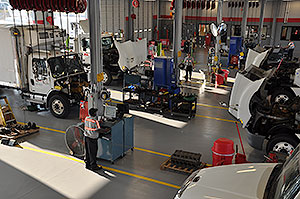
Ryder's garage. (Ryder)
Maintenance will be increasingly based on machine learning and artificial intelligence, said Braden Pastalaniec, vice president of sales of the transportation and logistics group at Uptake, a developer of AI-enabled asset-management software.
The data can give technicians full diagnostic information in advance. Then the technicians can be assisted through the repair, the work digitally recorded, and the paperwork filed automatically.
“Really, when we think about the future of maintenance, it’s one that is seamless, and it begins with AI determining when the right time is for maintenance,” he said.
A recent study co-authored by the Technology & Maintenance Council and FleetNet America found that the cost of an unscheduled truck repair was $407 in the third quarter of 2019, 24% higher than mechanical repairs in the same quarter in 2018. Five vehicle components accounted for 64% of all roadside repairs experienced by participating fleets: tires, brakes, lighting, power plants and cooling systems.
Preventing breakdowns is the primary goal, Uptake’s Pastalaniec said. His company’s software considers underlying signal data such as battery cranking voltage, which is transmitted in subsecond intervals when the truck is starting. That information is combined with recent trending data and historical failures from that fleet.
Pastalaniec said Uptake has worked with some of North America’s largest fleets and can reduce unplanned maintenance by 7-10% and fuel costs by 2-3%.
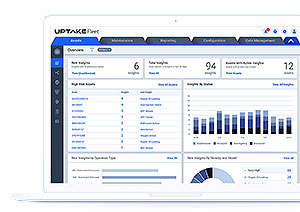
Uptake's system overview screen. (Uptake Fleet)
For one fleet, a diesel particulate filter alert appeared seven days before the first fault code came and 14 days before a technician confirmed the issue and made the repair. Uptake helps the Army perform predictive maintenance on the Bradley Fighting Vehicle, and the Marines do the same with their M88.
Hitachi America’s Chaffee said a large fleet service operation suspected trucks were in the shop too long and were undergoing too much rework. The operation was capturing a lot of data that wasn’t being applied predictively or prescriptively.
“We uncovered several millions in annual savings by shaving time off every shop visit, using predictive and prescriptive solutions that provided shops an intelligent recommendation of what is likely wrong, and how to fix it, before the truck arrived,” he said.
Predictive maintenance is even starting to appear for tires. Aperia’s wheel-mounted Halo tire inflation system automatically adds air when a tire drops below recommended pressure. About six years ago, Aperia added sensors to demonstrate the product was working, which led to its telematics product, Halo Connect.
Judith Monte, Aperia’s vice president of marketing and customer experience, said Halo Connect might show a slow leak or a mismatch that is invisible to the human eye, and it can provide guidance about when the tire will fail.
Monte said the most successful fleets embrace the technology and act on its insights. One challenge will be helping fleets understand the value.
“I can’t tell you how many drivers I’ve talked to where they insist that they can tell if a tire is low just by thumping on the tire,” she said.
Among the hurdles to adoption of predictive maintenance are fear of change, trust in the data, and an unwillingness to invest.
Cybersecurity will be an ongoing issue. Carriers must find the right technicians. The data providers must provide the right information.
Ryder’s Crawford said relying on one or two signals can lead to false positives. The industry must better understand the interdependency of multiple variables.
“In general, sensor data accuracy and everyone’s algorithms are still evolving,” she said.
Frito-Lay said it found many solutions that worked well as a desktop exercise, but the infrastructure did not exist to support implementation across more than 40,000 fleet assets.
Uptake’s Pastalaniec said predictive maintenance will come later with components that don’t have sensors or don’t currently make sense from a cost perspective, such as an oil filter.
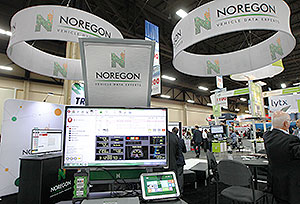
Noregon's vehicle interface is shown at a trade show. (John Sommers II for Transport Topics)
Another area where predictive maintenance hasn’t gained a foothold is oil change intervals. The data might show a truck wasn’t being driven as hard as the fleet thought it was and the oil can be changed later. But extending those intervals could violate the warranty, said Lee Lackey, product manager at Noregon.
“It’s kind of like nobody ever got fired for buying IBM. Nobody ever got fired for following the maintenance interval that was specified by the OEM,” he said.
Indeed, warranty issues remain a hurdle for fleets to overcome.
Paul Pettit, vice president of maintenance for Arkansas-based P.A.M. Transport, said his fleet tested two predictive maintenance products it couldn’t use because the manufacturer wouldn’t replace parts under warranty that hadn’t yet failed.
One report indicated an alternator wasn’t charging to its full capacity, but it didn’t throw a fault code, so the manufacturer didn’t replace it. Six months later, it still hadn’t had any issues.
“Basically, if we could prove to them, hey, this test is showing that this alternator is going to fail prematurely, and have the OEM component suppliers accept that, then we would be able to take a big step forward in predictive maintenance,” Pettit said. “But until there’s a warranty consideration that will accept that data, it’s going to be very difficult from the fleet side for us to be as proactive as we are ready to be.”
PacLease’s Tapp doesn’t see it that way. While his company is owned by a truck manufacturer, Paccar, he must pay for parts that aren’t covered by warranty, too. With customers counting on him, he’s willing to do so.
“If I know I can prevent a customer’s downtime, and I can keep them rolling by changing a particular component more often, that’s going to have to be a really, really expensive component for me not to change,” he said.
DTNA’s Khurana said his company has been discussing the warranty issue internally. He predicts the industry will move toward a model where maintenance is based on real-time insights instead of intervals through extended warranties, maintenance contracts and service contracts.
Joe Adams, chief engineer at Kenworth Truck Co., offered a similar perspective.

The industry is struggling to attract a new generation of technicians to maintain and repair increasingly high-tech trucks. Seth Clevenger spoke in Atlanta with Technology & Maintenance Council President Robert Braswell and Chairman Stacy Earnhardt to find out who's fixing the trucks of tomorrow. Hear a snippet, above, and get the full program by going to RoadSigns.TTNews.com.
“Predictive maintenance is in early stages, so changes to warranty policies have not happened,” he said. “As the systems build and the confidence grows, changes in policy will occur naturally.”
Frito-Lay said that “eventually the data speaks for itself” when fleets have a strong partnership with the manufacturer, and that it’s in the manufacturer’s best interest to replace parts if the data predicts a downstream failure.
For the technology to advance, providers need more open access to streaming data from OEMs and aftermarket telematics providers, Uptake’s Pastalaniec said.
SAE International is looking at telematics commonality with J1939 messaging that allows all components to use a central telematics platform.
Engines, transmissions and brakes have their own platforms, so a gateway is needed from truck manufacturers, Noregon’s Lackey said.
Looking ahead, a major advance will be what Lackey called “analytics on the edge.”
In the future, fleets could be able to deploy algorithms and machine learning capabilities that enable the vehicle itself to diagnose issues in real time rather than doing so at a maintenance facility.
Jack Poster, vehicle maintenance reporting standards service manager at TMC, said the level of engagement with predictive maintenance varies by fleet. Some still write things out by hand in the shop.
But he expects it to be more commonplace in the future. When the topic was brought up in the past, “people looked at us like this was like Buck Rogers or something,” he said. At a data conference last year, predictive maintenance was the No. 1-rated session.
“There are still going to be some naysayers that say, ‘If it ain’t broke, I’m not going to fix it. I’m not going to replace it,’ ” he said. “But common sense says there are some parts on the truck that are going to break.”
Want more news? Listen to today's daily briefing:



